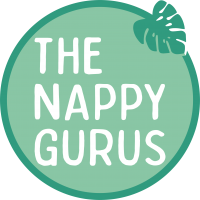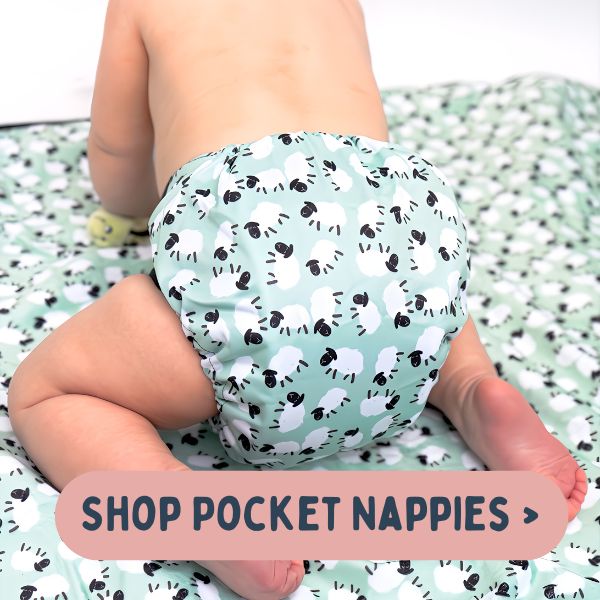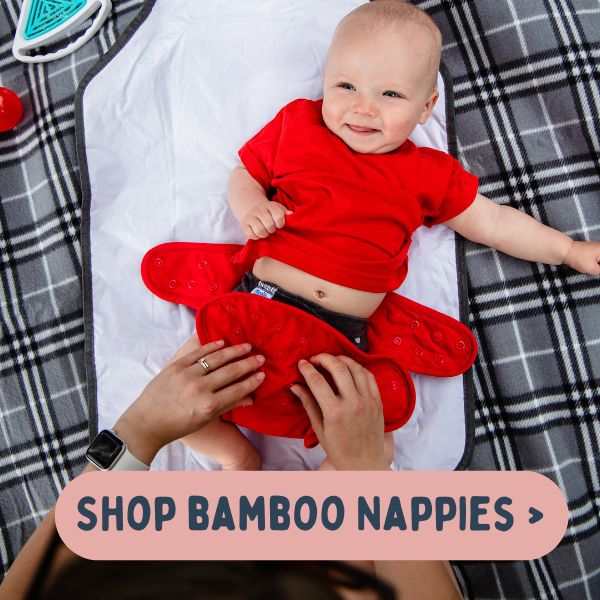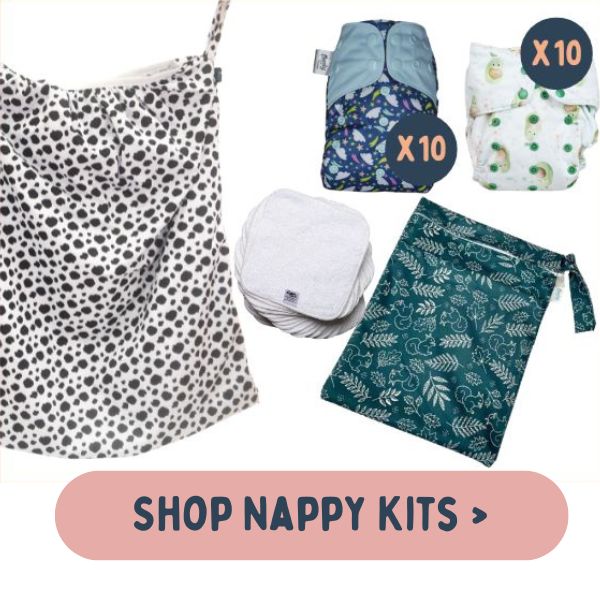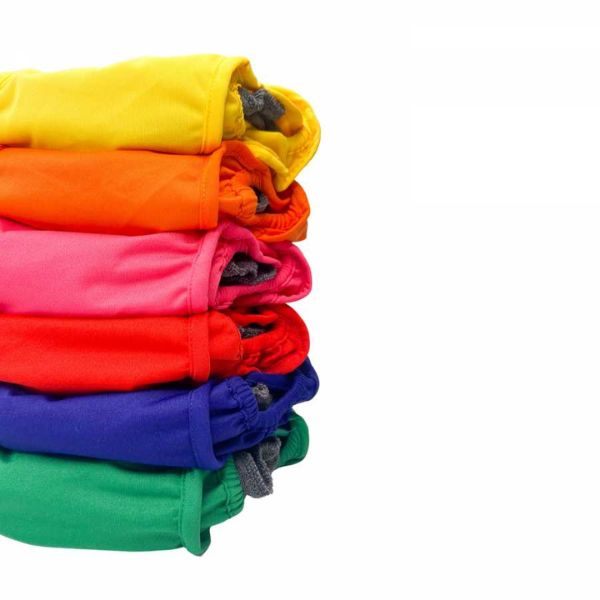Disposable vs Eco Nappies vs Reusable Nappies
What's the Difference Between Disposable vs. Eco vs. Reusable Nappies
You're expecting your first (or second) baby. You're aware that nappy changing is something you'll need to deal with one way or another. You're also environmentally aware and aren't keen on creating mountains of waste with nappies which could take hundreds of years to decompose.
With so many products labelled as "eco-friendly," it can be overwhelming to determine which options are genuinely kind to our planet.
This post aims to explain further, and hopefully explain further a bit more about the best nappies for the environment, comparing disposable, eco, and reusable for reasons above and beyond the environment. We'll also compare on cost, comfort, convenience and more.
I'll fully admit up front that I am biased towards reusable nappies as I own Cheeky Wipes & Cheeky Doodoo Nappies which we launched way back in 2008 with our bestselling reusable wipes. However I've also had 4 children and used cloth nappies exclusively with my first two babies and then a bit of both with the last two, so I think this makes me extremely well placed to compare both disposables and reusables!
You may also wish to take a look at the DEFRA / environment agency report comparing reusable and disposable nappies which was published last year to ZERO fanfare from the environment agency as they knew it was so damaging to the disposable nappy industry who have BIG pockets....
Disposable Nappies vs. Eco Nappies vs. Reusable Nappies
Choosing the right nappy for your child involves weighing the impact each type has on the environment and for YOUR family.
Below, we'll compare disposable, eco, and reusable nappies on a number of factors, and address the issue of greenwashing in "eco" nappies, which often still contribute significantly to waste and use a lot of resources.
Resources Used in Production
Disposable Nappies: 1/10
Disposable Nappies are generally full of plastic and chemical gels which makes them pretty nasty, so we've scored them as low as possible on this. Single use nappies use approximately 98% more resources to produce than reusable alternatives!
Eco Nappies: 3/10
Most eco nappies use wood pulp / cellulose and sugar cane based materials (bio plastics) which are still chemicals, but much more eco friendly materials generally. Some brands are also chlorine free. We score eco nappies worse by comparison due to the sheer volume of materials required ongoing.
You'll use around 5000 single use nappies for one child between newborn nappies up to being potty trained which is approximately 2.5 years. This compares to around 20 reusable nappies.
Reusable Nappies: 8/10
Defra states that the environmental impact of production is over 90% lower for a reusable nappy than for a single-use nappy.
Choose organic cotton or bamboo as the most ecofriendly materials for reusable nappies in terms of chemical usage in production. Microfibre is least ecofriendly, so look for recycled microfibre materials if possible to minimise chemical use in production.
Resources Used Post Production
Disposable Nappies: 6/10
Disposable nappies only use further resources in the supply chain through their transport and sale to customers. Shipping from factory to wholesaler or supermarket, then to individual stores and lastly to home by the consumer all has an environmental impact. In addition, the collection of used nappies by refuse collectors and then either being added to landfill or incinerated adds to resources required post production.
One final consideration is the treatment of poop. It is recommended by disposable nappy manufacturers on the packet that the poo from disposable nappies is flushed which has an impact on the amount of water used post production. That's because it is not safe to go to landfill. In reality though I've never seen anyone flush the poop from a disposable nappy.
Eco Nappies: 7/10
Eco nappy brands sold via subscription score better in post production as the supply chain is smaller, cutting out the middleman of shipping to stores. If we were considering nappies sold via supermarkets etc, this would not be the case.
Reusable Nappies: 3/10
There's no doubt that reusable nappies use energy and water in washing and drying. Choosing a renewable energy tariff, washing at lower temperatures (40c) and air drying rather than tumble drying can significantly reduce the eco impact of this however. This was recognised in the DEFRA report.
Convenience
Disposable Nappies: 8/10
Easily available and obviously are used once and then thrown away. However with ALL nappies, any solids should be flushed into the toilet so that we don't have a large amount of human waste entering landfill. In practice though no one ever does this, which is pretty gross.
Eco Nappies: 8/10
Also to be used once and thrown away, eco nappies should also have solids removed and flushed, but they are readily available. Many eco nappy companies such as kit and kin also offer subscription services which are even more convenient as the nappies are delivered to your door monthly.
Reusable Nappies: 6/10
Reusable nappies obviously have to be washed in the washing machine which is less convenient than simply throwing soiled nappies away. The upside is however that you'll never run out of nappies at 10pm on a Sunday evening! There's no denying however that if you're away from home or travelling, reusable nappies are less convenient.
So we do score reusable nappies lower on convenience but only by a slight margin.
Absorbency
Disposable Nappies: 8/10
Standard disposable nappies are very absorbent due to the chemical filled gels which they contain which can absorb up to 4 pee's at a time. The flip side of this of course is that this chemical filled gel sits beside your childs skin.
Eco Nappies: 7/10
Eco nappies tend to be slightly less absorbent than standard disposables as their absorbent material is cellulose / wood pulp.
Reusable Nappies: 8/10
Reusable nappies can be as absorbent as you need them to be because you can easily 'boost' absorbency by adding different layers of material if required.
This is why fitted two part nappies with a separate wrap are often recommended for overnight use by heavy wetters. You can add layers of quick absorbing microfibre, or high capacity bamboo to boost your nappy absorbency. You can also position absorbency where your child needs it most...at the front for boys and underneath for girls.
Waste
Disposable Nappies: 1/10
DEFRA acknowledges that the environmental impact of the disposal of a single-use nappy is 9x higher than that for a reusable nappy. Disposable nappies create a mountain of plastic filled waste which will take more than 500 years to decompose. In fact EVERY disposable nappy ever created (which hasn't been incinerated) is still in existence, rotting VERY slowly.
Eco Nappies: 2/10
Eco nappies create the same volume of waste (around 8 MILLION nappies a day in the UK), but in theory they should break down quicker and for that reason they are sometimes called biodegradable or compostable nappies. In reality though, they will only break down quicker if they aren't bagged in plastic bags and being placed in landfill is not the environment for them to do so.
This doesn't just mean using biodegradable nappy sacks.
If you dispose of your biodegradable nappy sack in a standard kitchen plastic bin bag, the nappy will take almost as long as a standard nappy to decompose. That's why Kit and Kin recommend that you 'place it outside of the non-biodegradable bin liner (but still within the bin itself) as this will maximise the exposure to oxygen'
Reusable Nappies: 9/10
Reusable nappies create very little residual waste which makes them the most environmentally friendly option. Not only can they be used by more than one child (mine were used by all 4 of my children) but when they're completely finished with, they can be repurposed as household cleaning items.
Microfibre boosters make amazing flat mop heads. Bamboo nappies are great for cleaning windows.
And when they can't even be used for this any longer, nappies can be recycled and made into new items. Only PUL wraps can't be used again.
Cost
Disposable Nappies: 6/10
You'll need around 4970 disposable nappies for your child, according to Cheeky Doodoo Nappies. At an average cost of 18p per nappy, that works out at around £900 if your child is in nappies for 2 and a half years. That's looking at branded nappies like Pampers and Huggies. It's worth pointing out that if you use supermarket nappies, this could be as low as £300 for Aldi nappies for example.
Eco Nappies: 3/10
The same amount of eco nappies would cost you significantly more than the usual disposables, however you may find it cheaper to set up a subscription. A 3 week rolling subscription to Kit & Kin for example, would cost you approximately £1,386 over 2 and a half years.
If you purchased a similar amount of 'Eco by Naty' nappies on your Ocado or Tesco shop that would amount to £1,688 over the same time period.
Reusable Nappies: 6/10
Reusable nappies of course have an upfront cost which is can be offputting if you're unsure how you're going to get on with your nappies. Assuming you need 20 nappies per child, we'd estimate on that costing around £300 although we have full time reusable nappy kits available for as little as £180 for 20 pocket nappies.
It's worth bearing in mind that there are ways to reduce this cost. Many local authorities offer reusable nappy incentive schemes to promote reusable nappies and reduce waste. This can be a great way of testing the water with reusables to see how you get on with a smaller starter set, or using this voucher to reduce the cost of buying your full set of nappies.
In addition, check out your local nappy library. They'll offer nappies on load for a period of time which are generally a mix of different types, so that you can try before you buy.
Comfort
Disposable Nappies: 5/10
Would you choose to wear a plastic knickers, paper knickers, or cloth knickers? My guess is you would choose cloth every time! On that basis, we've scored traditional disposables lowest.
Eco Nappies: 6/10
Eco friendly disposable nappies are less sweaty than plastic filled disposable nappies, but not as comfy as reusables.
Reusable Nappies: 7/10
Reusable nappies definitely have the win on comfort on your baby's skin. We did score them down a little because they are generally bulkier than disposables. That's isn't necessarily a bad thing though as according to the NHS, it can helps keep babies legs in the optimum position for good hip health.
Conclusion
When comparing on cost, comfort, waste, resources used and convenience we've scored reusable nappies as the best option overall:
- Reusable Nappies: 47/70
- Eco Disposable Nappies: 37/70
- Disposable Nappies: 35/70
Do you agree with our findings? In our next blog post we'll look at the best eco nappies 2024, both eco disposables and reusables.
We encourage you to continue exploring and asking questions to find the best option for your little one and the planet. Got more questions or need advice? Drop us a line, or check out our other guides or blogs which might be of interest:
- Types of cloth nappies
- Washing reusable nappies
- How to choose a great reusable nappy
- Cloth nappy guide
- Do biodegradable nappies actually exist?
About the Author: Helen Rankin, an advocate for sustainable living, embarked on her journey with reusable products when her first child was born in 2004. Facing limited options in cloth nappies, Helen’s passion only grew, leading her to launch Cheeky Wipes in 2008, right before welcoming her third child.
Helen's commitment to promoting sustainable solutions led to her taking over The Nappy Gurus in 2024. Today, she is excited to share her extensive knowledge and enthusiasm for all things reusable, helping a new generation of parents navigate eco-friendly choices for their childre
